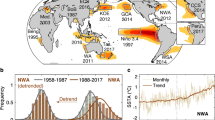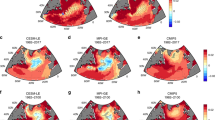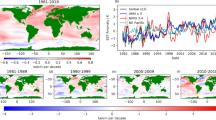Abstract
Gaining insight into anthropogenic influence on seasonality is of scientific, economic and societal importance. Here we show that a human-caused signal in the seasonal cycle of sea surface temperature (SST) has emerged from the noise of natural variability. Geographical patterns of changes in SST seasonal cycle amplitude (SSTAC) reveal two distinctive features: an increase at Northern Hemisphere mid-latitudes related to mixed-layer depth changes and a robust dipole pattern between 40° S and 55° S that is mainly driven by surface wind changes. The model-predicted pattern of SSTAC change is identifiable with high statistical confidence in four observed SST products and in 51 individual model realizations of historical climate evolution. Simulations with individual forcings reveal that GHG increases are the primary driver of changes in SSTAC, with smaller but distinct contributions from anthropogenic aerosol and ozone forcing. The robust human ‘fingerprint’ identified here is likely to have wide-ranging impacts on marine ecosystems.
This is a preview of subscription content, access via your institution
Access options
Access Nature and 54 other Nature Portfolio journals
Get Nature+, our best-value online-access subscription
$29.99 / 30 days
cancel any time
Subscribe to this journal
Receive 12 print issues and online access
$209.00 per year
only $17.42 per issue
Buy this article
- Purchase on Springer Link
- Instant access to full article PDF
Prices may be subject to local taxes which are calculated during checkout






Similar content being viewed by others
Data availability
The CMIP6 historical, single-forcing and FAFMIP simulation outputs are available via the Earth System Grid of the Program for Climate Model Diagnosis and Intercomparison (PCMDI): https://esgf-node.llnl.gov/search/cmip6/. HadISST data are available at: https://www.metoffice.gov.uk/hadobs/hadisst. ERSST data are available at: https://www.ncei.noaa.gov/products/extended-reconstructed-sst. COBE data are available at: https://psl.noaa.gov/data/gridded/data.cobe2.html. PCMDI data are available at: https://doi.org/10.22033/ESGF/input4MIPs.16921. ERA5 data are available at: https://www.ecmwf.int/en/forecasts/dataset/ecmwf-reanalysis-v5. IAP data are available at: https://climatedataguide.ucar.edu/climate-data/ocean-temperature-analysis-and-heat-content-estimate-institute-atmospheric-physics. The processed data are available via Figshare at https://doi.org/10.6084/m9.figshare.23271569 (ref. 69).
References
Bindoff, N. L. et al. in Climate Change 2013: The Physical Science Basis (eds Stocker, T. F. et al.) 867–952 (IPCC, Cambridge Univ. Press, 2014).
Hegerl, G. C. et al. Detecting greenhouse-gas-induced climate change with an optimal fingerprint method. J. Clim. 9, 2281–2306 (1996).
Santer, B. D. et al. A search for human influences on the thermal structure of the atmosphere. Nature 382, 39–46 (1996).
Tett, S. F. B., Mitchell, J. F. B., Parker, D. E. & Allen, M. R. Human influence on the atmospheric vertical temperature structure: detection and observations. Science 274, 1170–1173 (1996).
Stott, P. A. et al. External control of 20th century temperature by natural and anthropogenic forcings. Science 290, 2133–2137 (2000).
Santer, B. D. et al. Quantifying stochastic uncertainty in detection time of human-caused climate signals. Proc. Natl Acad. Sci. USA 116, 19821–19827 (2019).
Santer, B. D. et al. Exceptional stratospheric contribution to human fingerprints on atmospheric temperature. Proc. Natl Acad. Sci. USA 120, e2300758120 (2023).
Stott, P. A., Sutton, R. T. & Smith, D. M. Detection and attribution of Atlantic salinity changes. Geophys. Res. Lett. 35, L21702 (2008).
Santer, B. D. et al. Incorporating model quality information in climate change detection and attribution studies. Proc. Natl Acad. Sci. USA 106, 14778–14783 (2009).
Terray, L. et al. Near-surface salinity as nature’s rain gauge to detect human influence on the tropical water cycle. J. Clim. 25, 958–977 (2012).
Pierce, D. W., Gleckler, P. J., Barnett, T. P., Santer, B. D. & Durack, P. J. The fingerprint of human-induced changes in the ocean’s salinity and temperature fields. Geophys. Res. Lett. 39, L21704 (2012).
Marvel, K. & Bonfils, C. Identifying external influences on global precipitation. Proc. Natl Acad. Sci. USA 110, 19301–19306 (2013).
Gillett, N. P., Fyfe, J. C. & Parker, D. E. Attribution of observed sea level pressure trends to greenhouse gas, aerosol, and ozone changes. Geophys. Res. Lett. 40, 2302–2306 (2013).
Christidis, N. & Stott, P. A. Changes in the geopotential height at 500 hPa under the influence of external climatic forcings. Geophys. Res. Lett. 42, 10798–10806 (2015).
Barnett, T. P. et al. Penetration of human-induced warming into the world’s oceans. Science 309, 284–287 (2005).
Bilbao, R. A. F., Gregory, J. M., Bouttes, N., Palmer, M. D. & Stott, P. Attribution of ocean temperature change to anthropogenic and natural forcings using the temporal, vertical and geographical structure. Clim. Dynam. 53, 5389–5413 (2019).
Santer, B. D. et al. Human influence on the seasonal cycle of tropospheric temperature. Science 361, eaas8806 (2018).
Min, S.-K., Zhang, X., Zwiers, F. W. & Agnew, T. Human influence on Arctic sea ice detectable from early 1990s onwards. Geophys. Res. Lett. 35, L21701 (2008).
Qian, C. & Zhang, X. Human influences on changes in the temperature seasonality in mid- to high-latitude land areas. J. Clim. 28, 5908–5921 (2015).
Marvel, K. et al. Observed and projected changes to the precipitation annual cycle. J. Clim. 30, 4983–4995 (2017).
Duan, J. et al. Detection of human influences on temperature seasonality from the nineteenth century. Nat. Sustain. 2, 484–490 (2019).
Santer, B. D. et al. Robust anthropogenic signal identified in the seasonal cycle of tropospheric temperature. J. Clim. 35, 6075–6100 (2022).
Dwyer, J. G., Biasutti, M. & Sobel, A. H. The effect of greenhouse gas-induced changes in SST on the annual cycle of zonal mean tropical precipitation. J. Clim. 27, 4544–4565 (2014).
Alexander, M. A. et al. Projected sea surface temperatures over the 21st century: changes in the mean, variability and extremes for large marine ecosystem regions of Northern Oceans. Elementa 6, 9 (2018).
Kwiatkowski, L. et al. Twenty-first century ocean warming, acidification, deoxygenation, and upper-ocean nutrient and primary production decline from CMIP6 model projections. Biogeosciences 17, 3439–3470 (2020).
Timmermann, A., Jin, F. F. & Collins, M. Intensification of the annual cycle in the tropical Pacific due to greenhouse warming. Geophys. Res. Lett. 31, L12208 (2004).
Sobel, A. H. & Camargo, S. J. Projected future seasonal changes in tropical summer climate. J. Clim. 24, 473–487 (2011).
Chen, C. & Wang, G. Role of North Pacific mixed layer in the response of SST annual cycle to global warming. J. Clim. 28, 9451–9458 (2015).
Jo, A. R. et al. Future amplification of sea surface temperature seasonality due to enhanced ocean stratification. Geophys. Res. Lett. 49, e2022GL098607 (2022).
Liu, F., Lu, J., Luo, Y., Huang, Y. & Song, F. On the oceanic origin for the enhanced seasonal cycle of SST in the midlatitudes under global warming. J. Clim. 33, 8401–8413 (2020).
Dwyer, J. G., Biasutti, M. & Sobel, A. H. Projected changes in the seasonal cycle of surface temperature. J. Clim. 25, 6359–6374 (2012).
Capotondi, A., Alexander, M. A., Bond, N. A., Curchitser, E. N. & Scott, J. D. Enhanced upper ocean stratification with climate change in the CMIP3 models. J. Geophys. Res. Oceans 117, C04031 (2012).
Li, G. et al. Increasing ocean stratification over the past half-century. Nat. Clim. Change 10, 1116–1123 (2020).
Po-Chedley, S. et al. Natural variability contributes to model–satellite differences in tropical tropospheric warming. Proc. Natl Acad. Sci. USA 118, e2020962118 (2021).
Po-Chedley, S. et al. Internal variability and forcing influence model–satellite differences in the rate of tropical tropospheric warming. Proc. Natl Acad. Sci. USA 119, e2209431119 (2022).
Zelinka, M. D. et al. Causes of higher climate sensitivity in CMIP6 models. Geophys. Res. Lett. 47, e2019GL085782 (2020).
Santer, B. D. et al. Identifying human influences on atmospheric temperature. Proc. Natl Acad. Sci. USA 110, 26–33 (2013).
Solomon, S. et al. Emergence of healing in the Antarctic ozone layer. Science 353, 269–274 (2016).
Fyfe, J. C., Kharin, V. V., Santer, B. D., Cole, J. N. S. & Gillett, N. P. Significant impact of forcing uncertainty in a large ensemble of climate model simulations. Proc. Natl Acad. Sci. USA 118, e2016549118 (2021).
Meehl, G. A. et al. Context for interpreting equilibrium climate sensitivity and transient climate response from the CMIP6 Earth system models. Sci. Adv. 6, eaba1981 (2020).
Deser, C. et al. Isolating the evolving contributions of anthropogenic aerosols and greenhouse gases: a new CESM1 large ensemble community resource. J. Clim. 33, 7835–7858 (2020).
Shi, J.-R., Kwon, Y.-O. & Wijffels, S. E. Two distinct modes of climate responses to the anthropogenic aerosol forcing changes. J. Clim. 35, 3445–3457 (2022).
Shi, J.-R., Kwon, Y. & Wijffels, S. E. Subsurface ocean temperature responses to the anthropogenic aerosol forcing in the North Pacific. Geophys. Res. Lett. 50, e2022GL101035 (2023).
Ribes, A. & Terray, L. Application of regularised optimal fingerprinting to attribution. Part II: application to global near-surface temperature. Clim. Dynam. 41, 2837–2853 (2013).
Marvel, K. et al. Do responses to different anthropogenic forcings add linearly in climate models? Environ. Res. Lett. 10, 104010 (2015).
Maher, N., McGregor, S., England, M. H. & Gupta, A. S. Effects of volcanism on tropical variability. Geophys. Res. Lett. 42, 6024–6033 (2015).
O’Brien, J. P. & Deser, C. Quantifying and understanding forced changes to unforced modes of atmospheric circulation variability over the North Pacific in a coupled model large ensemble. J. Clim. 36, 19–37 (2023).
Deser, C., Simpson, I. R., Phillips, A. S. & McKinnon, K. A. How well do we know ENSO’s climate impacts over North America, and how do we evaluate models accordingly? J. Clim. 31, 4991–5014 (2018).
Fyfe, J. C., Saenko, O. A., Zickfeld, K., Eby, M. & Weaver, A. J. The role of poleward-intensifying winds on Southern Ocean warming. J. Clim. 20, 5391–5400 (2007).
Shi, J.-R., Talley, L. D., Xie, S.-P., Liu, W. & Gille, S. T. Effects of buoyancy and wind forcing on Southern Ocean climate change. J. Clim. 33, 10003–10020 (2020).
Shi, J.-R., Talley, L. D., Xie, S.-P., Peng, Q. & Liu, W. Ocean warming and accelerating Southern Ocean zonal flow. Nat. Clim. Change 11, 1090–1097 (2021).
Eyring, V. et al. Overview of the Coupled Model Intercomparison Project Phase 6 (CMIP6) experimental design and organization. Geosci. Model Dev. 9, 1937–1958 (2016).
Gillett, N. P. et al. The Detection and Attribution Model Intercomparison Project (DAMIP v1.0) contribution to CMIP6. Geosci. Model Dev. 9, 3685–3697 (2016).
Rayner, N. A. et al. Global analyses of sea surface temperature, sea ice, and night marine air temperature since the late nineteenth century. J. Geophys. Res. Atmos. 108, 4407 (2003).
Huang, B. et al. Extended Reconstructed Sea Surface Temperature, Version 5 (ERSSTv5): upgrades, validations, and intercomparisons. J. Clim. 30, 8179–8205 (2017).
Hirahara, S., Ishii, M. & Fukuda, Y. Centennial-scale sea surface temperature analysis and its uncertainty. J. Clim. 27, 57–75 (2014).
Durack, P. J., Taylor, K. E., Ames, S., Po-Chedley, S. & Mauzey, C. PCMDI AMIP SST and Sea-Ice Boundary Conditions Version 1.1.8 (Earth System Grid Federation, 2022); https://doi.org/10.22033/ESGF/input4MIPs.16921
Reynolds, R. W., Rayner, N. A., Smith, T. M., Stokes, D. C. & Wang, W. An improved in situ and satellite SST analysis for cimate. J. Clim. 15, 1609–1625 (2002).
Hersbach, H. et al. The ERA5 global reanalysis. Q. J. R. Meteorol. Soc. 146, 1999–2049 (2020).
Cheng, L. et al. Improved estimates of ocean heat content from 1960 to 2015. Sci. Adv. 3, e1601545 (2017).
Chan, D. & Huybers, P. Correcting observational biases in sea surface temperature observations removes anomalous warmth during World War II. J. Clim. 34, 4585–4602 (2021).
Gregory, J. M. et al. The Flux-Anomaly-Forced Model Intercomparison Project (FAFMIP) contribution to CMIP6: investigation of sea-level and ocean climate change in response to CO2 forcing. Geosci. Model Dev. 9, 3993–4017 (2016).
Hasselmann, K. On the Signal-To-Noise Problem in Atmospheric Response Studies (Royal Meteorological Society, 1979).
Van Den Dool, H. M., Saha, S. & Johansson, Å. Empirical orthogonal teleconnections. J. Clim. 13, 1421–1435 (2000).
Irving, D. B., Wijffels, S. & Church, J. A. Anthropogenic aerosols, greenhouse gases, and the uptake, transport, and storage of excess heat in the climate system. Geophys. Res. Lett. 46, 4894–4903 (2019).
Shi, J.-R., Wijffels, S. E., Kwon, Y. & Xie, S. Interhemispheric contrasts of ocean heat content change reveals distinct fingerprints of anthropogenic climate forcings. Geophys. Res. Lett. 50, e2023GL102741 (2023).
Allen, M. R. & Tett, S. F. B. Checking for model consistency in optimal fingerprinting. Clim. Dynam. 15, 419–434 (1999).
Bonfils, C. J. W. et al. Human influence on joint changes in temperature, rainfall and continental aridity. Nat. Clim. Change 10, 726–731 (2020).
Shi, J.-R., Santer, B. D., Kwon, Y.-O. & Wijffels, S. E. The emerging human influence on the seasonal cycle of sea surface temperature. Figshare https://doi.org/10.6084/m9.figshare.23271569 (2024).
Acknowledgements
We acknowledge the World Climate Research Programme’s Working Group on Coupled Modelling, which led the design of CMIP6 and coordinated the work, and we also thank individual climate modelling groups (listed in Supplementary Table 1) for their efforts in performing all of the model simulations analysed here. J.-R.S., Y.-O.K. and S.E.W. are supported by US National Science Foundation under grant number OCE-2048336. B.D.S. and Y.-O.K. were supported by the Francis E. Fowler IV Center for Ocean and Climate at Woods Hole Oceanographic Institution (WHOI).
Author information
Authors and Affiliations
Contributions
J.-R.S. and B.D.S. conceived the study. J.-R.S. conducted the analysis and wrote the first draft. J.-R.S., B.D.S., Y.-O.K. and S.E.W. contributed to interpreting the results, writing and editing the manuscript.
Corresponding authors
Ethics declarations
Competing interests
The authors declare no competing interests.
Peer review
Peer review information
Nature Climate Change thanks Masami Nonaka and the other, anonymous, reviewer(s) for their contribution to the peer review of this work.
Additional information
Publisher’s note Springer Nature remains neutral with regard to jurisdictional claims in published maps and institutional affiliations.
Extended data
Extended Data Fig. 1 Spatial patterns and zonal mean of the climatology of SST annual cycle amplitude (SSTAC) from four different observational products and from the multi-model mean (MMM) of the HIST simulations.
a Average of four different observed SST datasets. b HIST MMM. c Zonal-mean climatology of the HIST MMM and individual observed SST datasets. d Monthly climatology of SST averaged between 30˚N-45˚N from observations (dashed curves) and the fits of the first harmonic obtained through Fourier analysis (solid curves). Results are calculated over 1950 to 2014.
Extended Data Fig. 2 Leading EOF of SSTAC estimated from the HIST MMM.
a-d Results for four different analysis periods. The explained variances are shown in brackets.
Extended Data Fig. 3 S/N ratios from two selected CMIP6 models.
Results are as in Fig. 2b, but the ‘model only’ S/N ratios here (in grey) are from two models only: CNRM-CM6-1 and MRI-ESM2-0. Individual realizations from each model can have appreciable differences in their S/N behavior.
Extended Data Fig. 4 Scatterplot between the climate sensitivity of the 10 CMIP6 models analyzed here and the final value of the S/N ratio for the 65-year analysis period from 1950 to 2014.
The effective climate sensitivities are based on the results from ref. 40. The correlation between ECS and S/N ratio at 2014 is 0.55.
Extended Data Fig. 5 S/N ratios from the GHG, AER, O3, and NAT single-forcing runs.
Results are based on use of the same HIST fingerprint, which is searched for in the SSTAC changes of each single-forcing run (Method 1). a–d MMM result (the black curve) from GHG (a), AER (b), O3 (c) and NAT (d) single-forcing runs and results from individual realizations (the grey curves). GHG, AER, and NAT results are from 10 models with a total of 51 realizations; only four models with a total of 26 realizations were available for calculating O3 S/N ratios. The horizontal purple line is the 5% significance level. For further details refer to Methods.
Extended Data Fig. 6 Zonal-mean monthly-mean SST trends over 1950 to 2014.
a The ensemble mean of four observed datasets. b-d The MMM of the HIST, GHG, and O3 simulations. In contrast to Fig. 4, the trends are not expressed as departures from annual-mean trends.
Extended Data Fig. 7 Zonal-mean monthly-mean SST trends over 1950 to 2014 in four observed datasets.
a-d Results from four observed datasets: HadISST (a), ERSST (b), COBE (c) and PCMDI (d). The results are expressed as departures from annual-mean trends.
Extended Data Fig. 9 Zonal-mean monthly-mean trends over 1950 to 2014 in MLD and zonal wind stress.
a-b MLD trends from the IAP product and the MMM of the HIST simulations, respectively. Grey contours highlight the large MLD trends of −6 and −8 m/decade. c-d Zonal wind stress trends from ERA5 and the MMM of the HIST simulations.
Supplementary information
Supplementary Information
Supplementary Tables 1 and 2 and Figs. 1 and 2.
Rights and permissions
Springer Nature or its licensor (e.g. a society or other partner) holds exclusive rights to this article under a publishing agreement with the author(s) or other rightsholder(s); author self-archiving of the accepted manuscript version of this article is solely governed by the terms of such publishing agreement and applicable law.
About this article
Cite this article
Shi, JR., Santer, B.D., Kwon, YO. et al. The emerging human influence on the seasonal cycle of sea surface temperature. Nat. Clim. Chang. 14, 364–372 (2024). https://doi.org/10.1038/s41558-024-01958-8
Received:
Accepted:
Published:
Issue Date:
DOI: https://doi.org/10.1038/s41558-024-01958-8



